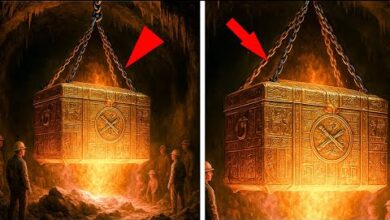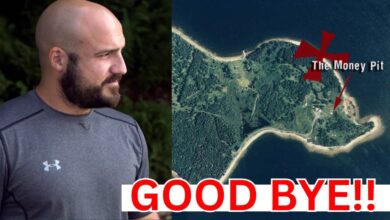The Curse of Oak Island: TOP 3 UNSOLVED MYSTERIES
The Curse of Oak Island: TOP 3 UNSOLVED MYSTERIES

Cryptic symbols. The symbol is definitely on the 90-foot stone, matching carvings found in a medieval church. Perfect, yeah. A megalithic formation of boulders possibly connected to priceless holy treasures. They created Nolan’s Cross. It would be in the form of the elongated cross, yes—a Stone Road. It’s something similar to what you have on Noah Island in the triangle-shaped swamp. It looks to be spitting here, yeah, and a sacred Masonic well. Well, it’s rather spectacular, matching the exact design of the original Money Pit. Beautiful, it certainly is.
Season 10 of The Curse of Oak Island is almost here, acorns, and when brothers Rick and Marty Lagina, along with their team, roll back across this causeway, they’ll launch their most groundbreaking attempt yet to find the treasure that people have been looking for since 1795. But they’ll also keep working to try to reveal just who was behind this great mystery, and although many intriguing suspects have emerged over the years, tonight we’re going to focus on the team’s startling discoveries that all point to the most compelling one. Get ready.
Number three: the cobblestone pathway. First scan coming up in order to see if any more evidence of man-made workings could be found related to the Stone Road. In 2021, cousins Alex Lagina and David Fernetti performed a ground-penetrating radar scan where a rocky feature met the eastern edge of the swamp. Look at that. What they found was extraordinary. “Oh, that’s interesting.”
“I mean, we started on the Stone Road, what was exposed, and at roughly the same depth, there is a consistent feature or anomaly about the same width that runs right along with it. Yeah, so we might be picking it up, even in the upland there, where we thought it ended, it might still continue.”
Incredibly, there’s a good chance the Stone Road is under us right here. The Stone Road appeared to extend into the uplands of the island on lot 15, but in order to prove it, the fellowship had to dig.
“If there’s a road, that’s what we’re after today and clues. Yeah, I’ve been wanting to dig this ever since we were out here delineating this thing,” said Marty Lagina.
On the groundwork of his son and nephew, Marty Lagina brought in a backhoe to see if another historic construct really did lie hidden just beneath the surface.
“Oh, whoa, whoa, whoa. Look at this. That could be the road.”
“You may want to take a look, really. There’s a lot of cobble there.”
“Yeah.”
“Kind of looks like down there.”
“It does, it does, yeah.”
“Alright, well, I’m going to go dig over there.”
“Yeah, that’s a good start.”
It was astonishing. The more they dug, the more evidence of a cobblestone path appeared. “This is getting interesting, Billy.” It wasn’t exactly the same kind of feature as the road in the swamp, but it had the team immediately speculating on what it might be.
“Wow, so you’ve done some work here since I left. Yeah, that’s impressive. So what do you think?”
“Well, we all have in our mind that it’s a nice cobble path coming up here, so they’re hauling something up, so they’re still filling in low areas just to make a path. Yes.”
“Yeah, if you look down here, the road went through here, we think.”
“Yeah, it essentially comes off of the Stone Road in the swamp.”
“Oh yeah, kind of like a central area. You’ve got the Money Pit over there, paved area, swamp, we’re in the middle of that area.”
“The interesting thing, you know, we were lucky enough to see an actual Roman Road in Portugal, but when we got to the higher elevations, this is what we saw. Yeah, it was somewhat rudimentary, just like here.”
And that brings us back to the Stone Road. And the most compelling evidence the team saw in 2021 connecting it—and the pathway, for that matter—to the Portuguese.
“Look at how beautifully constructed, I mean, rough and raw, but look at the curvature. It was in the medieval Templar stronghold of Alcáçova de Sara, Portugal. Look at the degree of slope. The remains constant. It’s beautiful.”
“If there is a Portuguese connection to the construction of the road in the swamp, maybe this is the blueprint.”
The Stone Road uncovered in the southeastern corner of the Oak Island Swamp was nearly identical to the one in Alcáçova de Sara, and incredibly, just beyond the Stone Road, Rick and Alex saw a cobblestone pathway just like the one on lot 15.
“Looks a lot like the stone path. Yeah, it looks the spitting image. Yeah, just fabulous.”
Number two: The five-finger drains.
It was back in 1850 when members of the Truro Company realized that the seawater that had been flooding the Money Pit since the removal of the 90-foot stone appeared to raise and lower with the daily tides. After building an earthen cover dam around Smith’s Cove, they began excavating and were stunned to discover five stone box drains in the shape of a hand beneath layers of coconut fiber and eelgrass, which acted as a filter to keep sand and silt out. The drains converged at the beach into a flood tunnel, which headed directly toward the Money Pit. But who could have constructed such an elaborate booby trap?
Welcome to Portugal, thank you. During their trip to Portugal in 2021, after the carvings that matched the 90-foot stone and the Ho Stone, as well as the Stone Road and pathways resembling those connected to the swamp, so here we are—welcome to the Convento de Cristo.
“Impressive.”
Researcher Korean Maul and historian Xiaofindero showed Rick and the team another incredible feature in the Convento de Cristo, the most sacred 12th-century convent of the Portuguese sect of the Knights Templar.
“This was also a functioning building, a functional community. We’re on top of a hill, and they needed water, so they built a huge aqueduct to bring water to this place so they could sustain themselves, and the waterways are underground. So there’s tunnels under this castle and under the convent, and they had a very special way to indicate where the aqueducts are on the ground. I think you’re going to find an interesting connection there, perhaps to Oak Island.”
“Are we allowed to go underground?”
“I’ll show you now.”
How they indicated the underground water stream.
“So, the first time I was here, I noticed this hand on the wall with this strange extended middle finger. It’s clearly a hand.”
“This, as far as I know, there’s five or six of those in the convent, and they indicate the aqueduct. So, these hands actually indicate how the water flows beneath the convent, which reminded me a little bit of the finger drains on Oak Island.”
“On Oak Island, the so-called finger drains were rock, yeah, and then a cap rock over the top of it. Is that how these are formed?”
“Yes, under these, you have a square pipe, like a square gutter, with a capstone. That’s exactly the way it’s described, right? As a finger drain. Yeah, on the island.”
“A finger drain, there you go.”
If there was ever a connection to Oak Island, this is it—finger drains in this convento built by the Templars, or at least Templar-influenced, exactly as we understand them in Smith’s Cove. It doesn’t get any closer a connection than that, at least not yet.
“We showed a hand there, you know, the bottom of the wall, and then it lands here. You see the stones here? Then the next hand is there, indicating the flow of the water.”
“Finger grate.”
“This is an exact representation of the finger drains on the island. Cap rock. They were engineers as much as, you know, religious monks—engineers extraordinaire. I mean, from what we’ve seen.”
Number one: The initiation well.
Welcome to Sintra. The Templar Knights came here, and they managed the land for a long time. On their last stop in Portugal one year ago, Rick Lagina and members of the team were treated to a tour of Quinta de Regaleira, an early 20th-century Masonic wonderland that had been built upon a 12th-century Knights Templar stronghold.
“There’s indeed something here that will remind you very much of Oak Island. The initiation well. That is the masterpiece here. Let’s go. I’d love to.”
Yeah, it’s easy to walk past. The beauty is inside. And as they entered through a stone passage, they could hardly comprehend what they were seeing.
“Well, Steve, what is this dimension? The diameter, 13 feet. That chamber at the bottom, I mean, it’s very Masonic at its core. What I can’t help compare it to is the design of the Money Pit. The initiation well has nine platforms. The nine floors sound like something that we have possibly on Oak Island. Yeah, The Money Pit.”
“Okay, let’s go down.”
“Smooth and easy. Go, watch your steps.”
When you look at the well, there are nine levels. We know there were nine levels in the original description of the Money Pit. We know that the original Money Pit was 13 feet in diameter. It’s curious if that is not a coincidence, and it seems as though it is not.
“And where was that information derived, and why was it important to replicate it? What does it mean? I don’t know.”
“Oh man, so you would perfectly see that oak tree from here, right? There was even an oak tree limb hanging over the center of the well, just like the one that was observed by Daniel McGinnis and his two friends, John Smith and Anthony Vaughn, when they discovered the Money Pit in 1795.”
“It is rather spectacular, isn’t it?”
“Yeah, remember, the Restalls thought there was a spiral staircase around the Money Pit.”
Now, it is a fact that the initiation well is a construct dated to about 1910, well after the discovery of the Money Pit. However, the spiral staircase that encircles the well was eerily identical to a discovery that wasn’t made until 1963 by the Restall family—a spiral tunnel encircling a portion of the shaft.
“What we’ve seen here is a vision that was not inspired, but instructed by knowledge from the past, which is being carried forward from the Knights Templar into the Order of Christ, into the Masonic thought, leading all the way up to this.”
“I truly believe in what we have learned in Portugal. It only enhances my belief that Oak Island is part of this legacy. I think we continue to persevere in that, with that hope, and for that, we thank you.”








